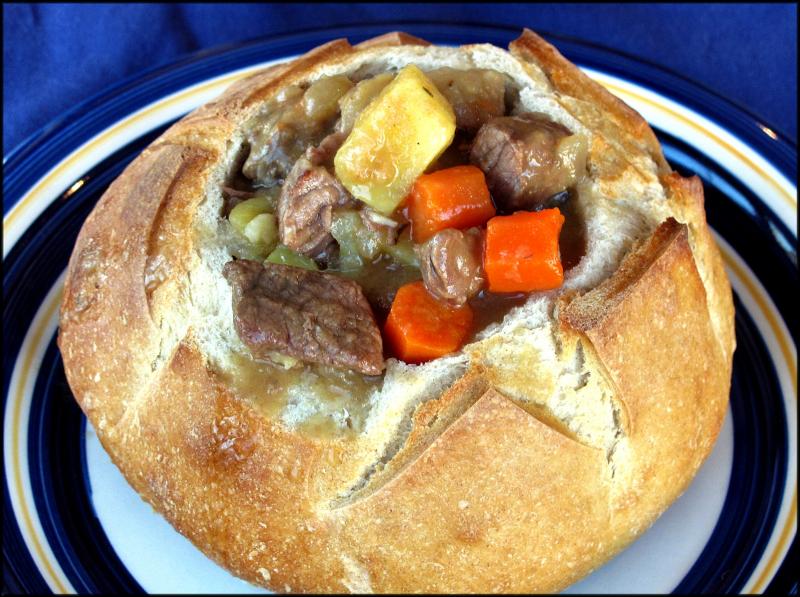Bread bowls are the upper crust of winter recipes
In reaction to the recent cold snap, I decided to make something rich and satisfying for dinner. There are any number of comfort-food options, from hearty pasta dishes to chicken pot pie, so I went to Lloyd’s Market for inspiration. I found some lovely parsnips in the produce bin and a package of well-trimmed beef cubes in the meat aisle.
Between my new purchases and the contents of my pantry, I had all the ingredients I would need for beef stew. I stopped at Old World Breads for one of Keith Irwin’s sourdough boules. However, instead of serving bread and butter on the side, this loaf would become the centerpiece - hollowed out and filled with piping-hot stew.
Referred to as “trenchers” during the European Middle Ages, bread has long been used to hold soups, thick chowders and stews. Crusty pieces of stale bread were hollowed enough to form a shallow trench to contain a mixture of liquid and solid foods. The only difference between then and now is that today it would be tasty to actually eat the bread.
According to food historians, you can find very specific instructions dating from the 15th century on the proper way to prepare trenchers. Slices measuring 6 inches by 4 inches would be cut from loaves of coarse bread that had been aged for at least four days. Typically, the empty trencher would be fed to the dogs or given to the poor, not eaten as part of the meal.
Bread held keys to status, as well. The highest-ranking person at the table (usually the host) would be served freshly baked bread, which is how we got the expression “upper crust.” Other guests would settle for day-old bread, while staff would eat the older loaves, saving the nicely hardened 4-day-old loaves to make trenchers.
By the 16th century, bread trenchers were still in use, but in a slightly different way. Instead of holding an entire serving of food, the trencher would be held in one hand, almost like a napkin. With your other hand, you selected a piece of meat from a communal dish, dipped it into one of the sauces arranged around the table and then placed the morsel in your mouth.
The bread bowl trend in this country surfaced in the late 1900s. Restaurants started serving chowders, chili, creamy soups and stews in edible bread bowls, while lifestyle magazines offered recipes for party dips in bread bowls. Last August, Philadelphia-based locations of Panera Bread started offering double bread bowls: a full loaf of sourdough with two openings cut out to hold various selections from their menu.
For our bread bowl stew, I opted for a traditional combination of beef and onions, simmered long enough for the beef to become tender before adding potatoes, parsnips and carrots. A bay leaf, thyme and Worcestershire sauce formed the backbone of the seasoning profile, which was enriched by the addition of Guinness along with beef stock.
As a final step, the stew was thickened. Some recipes call for making a slurry from flour and a few spoonfuls of the liquid in the pot, but this often becomes lumpy. I prefer making a roux – cooking butter and flour together to create a golden paste to whisk in during the final minutes of cooking. This approach avoids lumps and eliminates any unpleasant floury flavor.
While bread bowls are fun and ideal containers for certain foods, they don’t work with everything. They’re best with very thick, creamy dishes. If you try to fill them with a thinner, broth-based mixture, the bread will disintegrate as it absorbs the liquid, leaving you with a soggy mess. However, our stew (see photo) worked perfectly and we enjoyed eating the bowl.
Bread Bowl Beef Stew
1 1/2 lbs beef cubes
1/2 t salt
2 T flour
2 T olive oil
1 chopped onion
3 chopped garlic cloves
2 1/2 C beef stock
14.9 oz can Guinness
1 bay leaf
1 sprig thyme
1/2 t salt
3 shakes of Worcestershire sauce
3 carrots
2 parsnips
2 potatoes
1 T flour
1 T butter
6 round bread loaves*
Heat olive oil in a large pot over medium-high heat. In a bowl or bag, toss the beef cubes with the flour and salt. Once the oil is hot, add in the beef cubes. Sauté until browned, about 6-8 minutes, turning often. Stir in the onion and sauté for about 5 minutes. Add the garlic and cook until fragrant, about 2 minutes. Turn down heat to medium low and add the stock, stirring to release any brown bits on the bottom of the pot. Stir in Guinness, bay leaf, thyme, salt and Worcestershire sauce. Simmer for 30 minutes. Meanwhile, peel the carrots, parsnips and potatoes. Cut into a uniform 1-inch dice. Add to the stew and continue cooking at a simmer until the vegetables are tender, about 45 minutes. Meanwhile, melt the butter in a small pan over medium and add flour; stir constantly until golden brown. In the final minutes of cooking the stew, whisk in the roux, stirring to combine throughly. Using a serrated knife, cut out a circle in the top of each loaf and remove. Continue cutting around the inside of the loaf to create a bowl; leave about 1 inch of bread on all sides and the bottom. To serve, ladle stew into the bread bowl and serve immediately. *Note: for a shared bread bowl, a larger loaf may be used; for individual bowls, use round loaves about 5 inches in diameter. Yield: 6 servings.
Cheesy Bread Bowl Dip
1 sourdough boule
8 oz cream cheese
1 1/2 C shredded sharp cheddar cheese
1 1/2 C shredded mozarella
1/2 C Guinness
1 grated garlic clove
1 T grated onion
pinch cayenne pepper
2 T grated Parmesan cheese
Preheat oven to 350 F. Line a baking sheet with aluminum foil; set aside. Cut out a circle in the top of the bread loaf; set aside the top piece. Cut away the inside of the loaf to create a bowl; leave 1 inch of bread on all sides and the bottom. Place bread bowl on prepared baking sheet. In a mixing bowl, whip cream cheese until fluffy. Stir in cheddar cheese and 1 C mozzarella cheese. Add Guinness, grated garlic, grated onion and cayenne; stir thoroughly to combine. Transfer cheese mixture to the prepared bread bowl and top with remaining 1/2 C mozzarella and Parmesan cheese. Replace the top on the bread bowl and bake for 20 minutes. Remove top and place bread bowl on a serving plate along with crackers or celery and carrot sticks for dipping.





















































